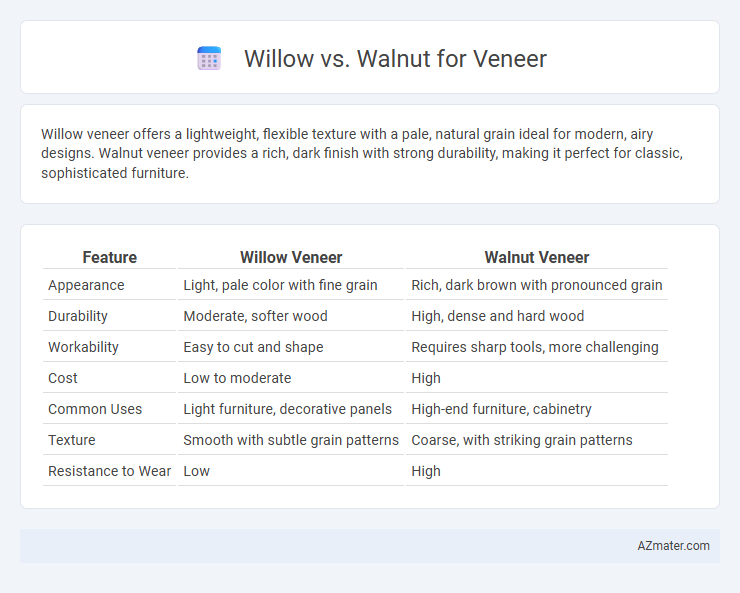Willow veneer offers a lightweight, flexible texture with a pale, natural grain ideal for modern, airy designs. Walnut veneer provides a rich, dark finish with strong durability, making it perfect for classic, sophisticated furniture.
Table of Comparison
| Feature | Willow Veneer | Walnut Veneer |
|---|---|---|
| Appearance | Light, pale color with fine grain | Rich, dark brown with pronounced grain |
| Durability | Moderate, softer wood | High, dense and hard wood |
| Workability | Easy to cut and shape | Requires sharp tools, more challenging |
| Cost | Low to moderate | High |
| Common Uses | Light furniture, decorative panels | High-end furniture, cabinetry |
| Texture | Smooth with subtle grain patterns | Coarse, with striking grain patterns |
| Resistance to Wear | Low | High |
Introduction to Wood Veneers
Willow and walnut veneers are popular choices in woodworking due to their distinct aesthetic and physical properties. Willow veneer features a light, creamy color with a subtle grain pattern, ideal for creating bright, contemporary designs. Walnut veneer offers a rich, dark brown hue with pronounced grain variations, providing a luxurious and classic appearance in furniture and cabinetry.
Willow Veneer: Characteristics and Features
Willow veneer is prized for its lightweight nature and distinct grain pattern, featuring fine, wavy lines that create an elegant, natural texture. This veneer is softer compared to walnut, which enhances ease of cutting and shaping, making it ideal for delicate woodworking projects and detailed inlays. Willow's pale, creamy to light brown tones provide a versatile base for staining or finishing, offering more customization options than the rich, deep brown hues typical of walnut veneer.
Walnut Veneer: Properties and Appeal
Walnut veneer is prized for its rich, deep brown color with striking grain patterns that add warmth and elegance to furniture and cabinetry. Its durability and fine texture make it an excellent choice for high-end applications, offering resistance to wear and a smooth finish that complements both modern and traditional designs. Compared to willow veneer, walnut provides superior hardness and a more luxurious appearance, making it a preferred material for premium woodworking projects.
Color and Grain Comparison
Willow veneer features a light, creamy color with subtle, fine grain patterns that create a smooth and uniform appearance, making it ideal for minimalist and modern designs. Walnut veneer offers a rich, deep brown hue with striking, pronounced grain lines that add warmth and character to furniture or paneling. The contrast between willow's soft, understated tones and walnut's bold, textured grains allows for versatile application depending on the desired aesthetic impact.
Durability and Strength: Willow vs Walnut
Walnut veneer offers superior durability and strength compared to willow veneer, making it ideal for high-traffic furniture and surfaces requiring long-lasting wear. Walnut's dense grain structure provides excellent resistance to dents, scratches, and warping, whereas willow veneer tends to be softer and more prone to damage under heavy use. Choosing walnut veneer ensures enhanced structural integrity and longevity in wood projects.
Workability and Application Techniques
Willow veneer offers excellent workability due to its fine, uniform texture and flexibility, making it ideal for curved and intricate surfaces. Walnut veneer features a harder, denser grain that requires sharper tools and more careful handling but provides a rich, luxurious finish suited for high-end furniture and cabinetry. Both veneers respond well to adhesives and finishing techniques, with willow excelling in bending applications and walnut preferred for flat panel installations.
Cost Differences and Availability
Willow veneer generally costs less than walnut veneer due to its faster growth rate and greater availability in North American regions, making it more budget-friendly for large projects. Walnut veneer, prized for its rich color and distinct grain patterns, commands a higher price owing to its slower maturation and limited supply, especially the highly sought-after black walnut species. Availability of walnut veneer is often constrained, leading to longer lead times compared to the more readily available willow veneer, impacting project scheduling and budgeting.
Environmental Impact and Sustainability
Willow veneer is highly sustainable due to its rapid growth rate and renewable properties, making it a low-impact choice for eco-conscious projects. Walnut veneer, while prized for its rich color and durability, has a slower growth cycle, leading to higher environmental costs and potential concerns about deforestation. Choosing willow over walnut can significantly reduce carbon footprint and promote sustainable forestry practices.
Popular Uses and Design Trends
Willow veneer is favored for its light, airy grain patterns and pale color, making it ideal for contemporary furniture and decorative panels that emphasize natural, minimalist aesthetics. Walnut veneer, known for its rich, dark brown hues and distinctive grain, is popular in luxury cabinetry, high-end flooring, and classic or modern interior designs seeking warmth and sophistication. Design trends highlight willow veneer in Scandinavian-style spaces and walnut veneer in mid-century modern and industrial-inspired decor.
Choosing the Right Veneer for Your Project
Willow veneer offers a lightweight, fine-grained texture with natural flexibility, ideal for furniture requiring smooth curves and a rustic aesthetic. Walnut veneer features a rich, dark brown hue with striking grain patterns, providing durability and an elegant finish suitable for high-end cabinetry and luxury interiors. Selecting between willow and walnut veneer depends on the desired visual impact, structural needs, and overall project style.

Infographic: Willow vs Walnut for Veneer
 azmater.com
azmater.com